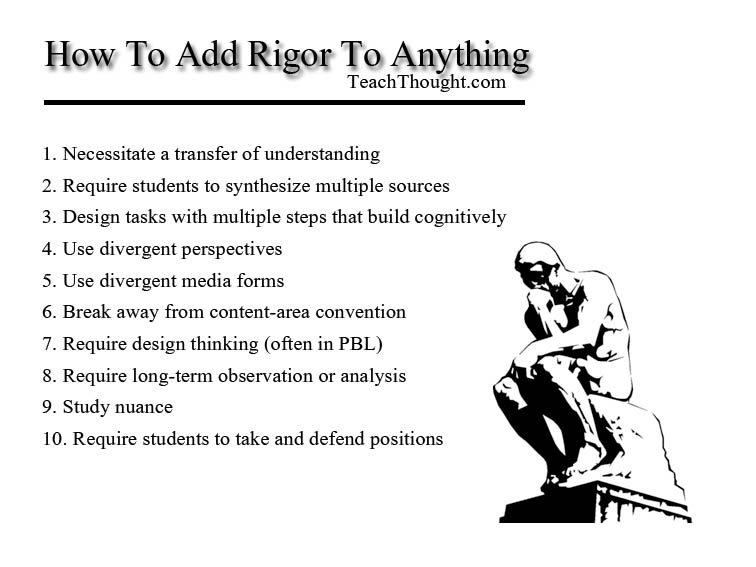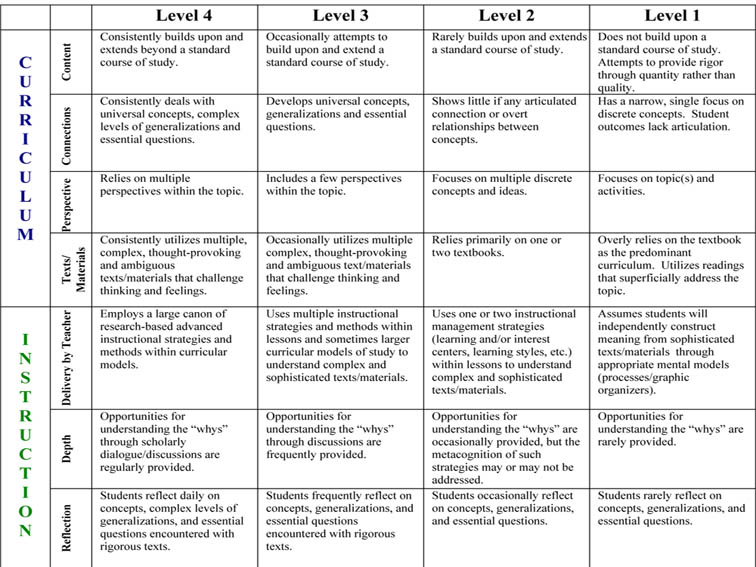
How To Add Rigor To Any Lesson, Unit, Or Assessment
by Terry Heick
Rigor is a fundamental piece of any learning experience.
It is also among the most troublesome due to its subjectivity. What does it mean? What are its characteristics? Rigorous for whom? And more importantly, how can you use to promote understanding?
Barbara Blackburn, author of “Rigor is not a 4-Letter Word,” shared 7 ‘myths’ concerning rigor, and they are indicative of the common misconceptions: that difficult, dry, academic, sink-or-swim learning is inherently rigorous.
Myth #1: Lots of Homework is a Sign of Rigor
Myth #2: Rigor Means Doing More
Myth #3: Rigor is Not For Everyone
Myth #4: Providing Support Means Lessening Rigor
Myth #5: Resources Equal Rigor
Myth #6: Standards Alone Take Care Of Rigor
Myth #7: Rigor Is Just One More Thing To Do
Why Rigor Matters
Rigor matters because it imposes cognitive load on students, forcing them to confront misconceptions, reconsider positions, separate the implicit from the explicit, and other critical thinking practices that distinguish shaky familiarity from true understanding.
As such, it’s different for every student. If students can’t consistently negotiate rigorous tasks, either understanding or thinking habits should be more closely examined. But if work is beyond their Zone of Proximal Development, students are only being setup for disengagement, frustration, and ultimately failure.

10 Strategies To Add Rigor To Any Lesson, Unit, or Assessment
Several common classroom tasks are inherently rigorous, including reading idea-dense literature, taking notes, and using the writing process itself, but these are rarely engaging, and don’t always fit with a given academic standard or task. But the following ten strategies can be used to add rigor to almost anything.
1. Necessitate a transfer of understanding
By definition, transfer requires a student to apply knowledge in new and unfamiliar situations, an inherently rigorous process. If you can encourage self-initiated transfer (unprompted or coached), all the better.
2. Require students to synthesize multiple sources
In rigorous tasks, learners will often need to synthesize data, positions, or theories from multiple sources or perspectives. Whether these are literary perspectives, scientific viewpoints, religious ideas, mathematical theories, or any other fundamentally subjective content, when learners have to analyze, internalize, and reconcile multiple perspectives to create a new position or perspective, rigor is a safe bet.
3. Design tasks with multiple steps that build cognitively
Not all tasks that require multiple steps are inherently rigorous (fill out the worksheet, turn it in, read the book, answer the questions, talk to your partner about your answers and turn them in is neither a unique or rigorous approach to learning).
If the tasks build (somewhat parallel to Bloom’s Taxonomy), rigor is more likely. In this approach, a student might define “conflict,” analyze cause-effect of a specific conflict, research the sources of said conflict, then design some kind of short-term solution to one critical cause of said conflict. This approach starts simple, becomes more complex, and is likely to challenge any student no matter how “proficient” their understanding.
4. Use divergent perspectives
Use authors, philosophers, artists, content experts, or other thinkers who make authentic cases of their own that offer contrasting perspectives. Not only does this encourage argument analysis, credibility, etc., but also models how elusive and illusory “truth is,” a rigorous idea of its own.
5. Use divergent media forms
Rather than two (or more) texts, require students to analyze a conversation, a poem, and a tweet; a YouTube video, an encyclopedia resource, and an interview with an expert. The more (seemingly) awkward and divergent, the more learners are challenged to develop new strategies to find solutions.
6. Break away from content-area convention
Use literature to frame math. Use science to promote political discussions. Extract the philosophy from cartoons. Find poetry in the stars. Use Google Earth to make sociological observations. These approaches force students to revise schema for new situations, a key characteristics of rigor.
7. Require design thinking (often in project-based learning)
Build design thinking into rubrics or scoring criteria, supply exemplars, or model their use, but whatever you do, be sure that elements of design thinking, creativity, and the “tinker culture” aren’t just “encouraged” but required for the student to find success.
8. Require long-term observation or analysis
Another potential use of project-based learning or learning simulations, when students are required to observe long-term, cognitive actions such as identifying patterns, cause-effect analysis, and problem-solution thinking are natural by-products.
9. Study nuance
Nuance is often overlooked, and offers a world of rigor due to the unique thinking habits it requires.
10. Require students to take and defend positions
This can be done first in small groups, then socialized to larger groups (hopefully outside the classroom). A ‘position’ requires a kind of cognitive ownership that is not only indirectly engaging, but also intellectually stimulating and even emotionally demanding, requiring students to think “Why?” as much as “What?,” “When?,” and “Where?”
Rigor is Always Accessible
As Strong, Silver, and Perini explain in “Teaching What Matters,” rigor is a “quality of content, not a measure of the quantity of the content we cover.” Certain content areas may be more inherently rigorous than others (Astrophysics comes to mind), but rigor can be added to anything.
Watch an episode of Spongebob, have students reconcile Patrick’s presumptions about friendship with Whitman’s ideas on the rugged individual, ask students to study the nuance of Spongebob’s body language and speech patterns over the course of several episode to reveal patterns, then require them to socialize their thinking in small groups to present a new theory on interpersonal relationships from America’s inception to today. You’ve used #s 2, 4, 5, and 10.
The above is a purposefully absurd idea, but the premise is clear: Rigor is always accessible. For more information, read our post: 5 Guiding Questions To Evaluate Rigor In A Curriculum.
Image attribution North Carolina Department of Public Instruction and flickr user woodleywonderworks
